
Around 40 people, mostly pupils, have been killed at a school in western Uganda by rebels linked to the Islamic State group (IS).
A further eight people remain in a critical condition after the attack on Lhubiriha secondary school in Mpondwe.
Boys staying in dormitories are among the dead. Several others, mostly girls, have been abducted, authorities say.
The Allied Democratic Forces (ADF) – based in the Democratic Republic of Congo (DRC) – have been blamed.
- Warning: Some people may find details in this story distressing.
The attack happened at around 23:30 (20:30 GMT) on Friday at the school in the Kasese district in western Uganda.
Over 60 people are educated at the school, most of whom live there.
Some five suspected ADF rebels carried out the attack, burning the school buildings and looting the food store, the Ugandan army has said.
Some of the boys were burnt or hacked to death, Maj Gen Dick Olum from the army said.
Survivors told local media that the attackers used machetes against the students before throwing a bomb into a dormitory.
The ages of the victims are not known.
Some of the bodies are said to have been badly burnt and DNA tests will need to be carried out to identify them.
The attackers are said to have torched the students’ mattresses and are also thought to have detonated bombs in the region.
Photos of burning buildings at the school have circulated on social media.
Members of the wider community are possibly among the dead. A number of students remain unaccounted for and the exact number of those who died is still unclear.
Many of the bodies were transferred to Bwera Hospital, national police spokesperson Fred Enanga said.
Soldiers are pursuing ADF insurgents towards the DRC’s Virunga national park – Africa’s oldest and largest national park which is home to rare species, including mountain gorillas.
Militias including the ADF also use the vast expanse, which borders Uganda and Rwanda, as a hideout.
“Our forces are pursuing the enemy to rescue those abducted and destroy this group,” defence spokesperson Felix Kulayigye said on Twitter.
The Ugandan army has also deployed helicopters to help track the rebel group over mountainous terrain.

Uganda and the DRC have held joint military operations in the east of DR Congo to prevent attacks by the ADF.
Security forces had intelligence that rebels were in the border area on the DRC side for at least two days before Friday night’s attack, Maj Gen Olum said.
But local residents have criticised the authorities for not being prepared for an attack.
“If they are telling us the borders are secure and security is tight, I want the security to tell us where they were when these killers came to kill our people,” one resident told reporters.
The deadly episode follows last week’s attack by suspected ADF fighters in a village in the DRC near to the Ugandan border. Over 100 villagers fled to Uganda but have since returned.
The attack on the school, located less than two kilometres (1.25 miles) from the DRC border, is the first such attack on a Ugandan school in 25 years.
In June 1998, 80 students were burnt to death in their dormitories in an ADF attack on Kichwamba Technical Institute near the border of DRC. More than 100 students were abducted.
The group may target schools as a way of recruiting children, according to Richard Moncrieff, an expert in the region at the International Crisis Group. But they also do it for the shock value, he told the BBC.
“These are terrorist groups who want to make and impact through violence, they want to show that they are there, show that they are active to their colleagues and allies in ISIS in other parts of the world,” Mr Moncrieff said, using another acronym for IS.
The ADF was created in eastern Uganda in the 1990s and took up arms against long-serving President, Yoweri Museveni, alleging government persecution of Muslims.
Muslims make up almost 14% of the Ugandan population, according to official government figures, though the Ugandan Muslim Supreme Council estimates the figure is closer to 35%.
Some members of the Ugandan Muslim community say they face discrimination in public life, including in education and the workplace.
After defeat by the Ugandan army in 2001, the ADF relocated to North Kivu province in the DRC.
The group’s principal founder, Jamil Makulu, was arrested in Tanzania in 2015 and is in custody in a Ugandan prison.
ADF rebels have been operating from inside the DRC for the past two decades.
Makulu’s successor, Musa Seka Baluku, reportedly first pledged allegiance to the Islamic State group in 2016, but it was not until April 2019 that IS first acknowledged its activity in the area.
Islamic State as a group has been mostly defeated, though there are significant numbers of IS-affiliated militant groups across the Middle East and Africa.
After years of not operating openly in Uganda, the ADF was blamed for a series of attacks in late 2021 including suicide bombings in Uganda’s capital
















+ There are no comments
Add yours